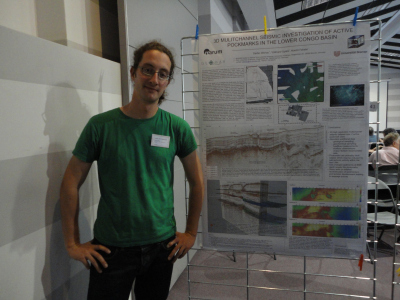Page path:
Bremen International Graduate School for Marine Sciences
Stefan Wenau
Report of GLOMAR PhD student Stefan Wenau about his participation in the 11th International Conference of Gas in Marine Sediments, Nice, France, 4 - 7 September 2012
This conference has over 20 years of history in bringing together people working on the topic of gas in marine sediments using different kinds of methods, from geochemical modeling to seismic surveys. The participation of only just above 100 people ensured a very relaxed atmosphere where individual discussion could take place. Although the community attending this conference seemed rather small, the diversity of study subjects presented was very high. Talks were given on various geographical regions in talks of 15 minutes including discussion. This rather limited time frame sometimes prohibited intensive discussion during the sessions, however, the small number of participants allowed for continued exchanged over lunch or coffee.
My oral presentation was set in a session dealing mostly with seismic investigation of sub-seafloor gas structures. As I am working in the Lower Congo Basin offshore Angola and Gabon, I was very interested to see two presentations dealing with gas seepage in that same area. These presentations used industry-scale 3D seismic data (TOTAL) on the middle and upper slope in the region to investigate seepage features in the sedimentary record. My presentation of integrated multi-frequency data including multichannel seismics, watercolumn and sediment echosounders, multibeam echosounders and geological sampling augmented some of their observations that were generally lacking the seafloor high-resolution component. Consequently we had some productive discussion during the poster sessions and I may try to establish contact with their research center in southern France as I may be able to benefit from some deep seismic profiles in my study area.
The poster sessions were organized in two blocks giving sufficient time to explore all of the about 45 posters. My poster presentation dealt with my new study area to the north of the Congo Canyon where a 3D dataset was acquired in 2002. Since my work on this new topic has just begun, I could not present conclusions but rather my work plan and expected results. Other interesting posters for my work included the ROV mapping of biological seep-related communities in the Regab pockmark also in the Lower Congo Basin on which I may also get to work in the next year. Furthermore, some seismic modeling of seep-carbonate bodies in marine sediments gave new insights into the interpretation of seepage features in geophysical data. Especially the attempt to relate mapped outcrops of ancient seep-carbonates to seismic images of active seafloor seeps was impressive.
This conference gives a perfect opportunity to present any work dealing with gas in a marine environment. For PhD students it is especially beneficial as the small scale allows for interaction with everybody and real discussion of data. Furthermore, the atmosphere of the community is very friendly and the setting in Nice with the attached excursion to the Oceanographic Museum in Monaco made this a great conference. The next GIMS will take place in 2014 in Taiwan.
I would like to thank GLOMAR for funding my conference participation allowing me to present my work and benefit from the scientific exchange.
My oral presentation was set in a session dealing mostly with seismic investigation of sub-seafloor gas structures. As I am working in the Lower Congo Basin offshore Angola and Gabon, I was very interested to see two presentations dealing with gas seepage in that same area. These presentations used industry-scale 3D seismic data (TOTAL) on the middle and upper slope in the region to investigate seepage features in the sedimentary record. My presentation of integrated multi-frequency data including multichannel seismics, watercolumn and sediment echosounders, multibeam echosounders and geological sampling augmented some of their observations that were generally lacking the seafloor high-resolution component. Consequently we had some productive discussion during the poster sessions and I may try to establish contact with their research center in southern France as I may be able to benefit from some deep seismic profiles in my study area.
The poster sessions were organized in two blocks giving sufficient time to explore all of the about 45 posters. My poster presentation dealt with my new study area to the north of the Congo Canyon where a 3D dataset was acquired in 2002. Since my work on this new topic has just begun, I could not present conclusions but rather my work plan and expected results. Other interesting posters for my work included the ROV mapping of biological seep-related communities in the Regab pockmark also in the Lower Congo Basin on which I may also get to work in the next year. Furthermore, some seismic modeling of seep-carbonate bodies in marine sediments gave new insights into the interpretation of seepage features in geophysical data. Especially the attempt to relate mapped outcrops of ancient seep-carbonates to seismic images of active seafloor seeps was impressive.
This conference gives a perfect opportunity to present any work dealing with gas in a marine environment. For PhD students it is especially beneficial as the small scale allows for interaction with everybody and real discussion of data. Furthermore, the atmosphere of the community is very friendly and the setting in Nice with the attached excursion to the Oceanographic Museum in Monaco made this a great conference. The next GIMS will take place in 2014 in Taiwan.
I would like to thank GLOMAR for funding my conference participation allowing me to present my work and benefit from the scientific exchange.



